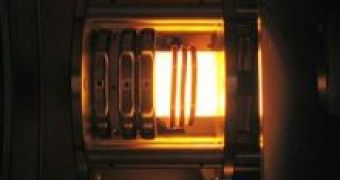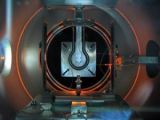The European Space Agency (ESA) and the Australian National University have successfully tested a new design of spacecraft ion engine that dramatically improves performance over present thrusters and marks a major step forward in space propulsion capability.
Ion engines are a form of electric propulsion and work by accelerating a beam of positively charged particles (or ions) away from the spacecraft using an electric field. ESA is currently using electric propulsion on its Moon mission, SMART-1. The new engine is over ten times more fuel efficient than the one used on SMART-1. "Using a similar amount of propellant as SMART-1, with the right power supply, a future spacecraft using our new engine design wouldn't just reach the Moon, it would be able to leave the Solar System entirely," says Dr Roger Walker of ESA's Advanced Concepts Team, Research Fellow in Advanced Propulsion and Technical Manager of the project.
The new experimental engine, called the Dual-Stage 4-Grid (DS4G) ion thruster, was designed and built under a contract with ESA in the extremely short time of four months by a dedicated team at the Australian National University.
Traditional ion engines use three closely separated perforated grids containing thousands of millimeter-sized holes attached to a chamber containing a reservoir of the charged particles. The first grid has thousands of volts applied, and the second grid operates at low voltage. The voltage difference over the gap between the two grids creates an electric field that attracts the ions from the reservoir and accelerates them outside into space. The higher the voltage difference, the faster the ions are expelled, the greater the fuel efficiency of the thruster and the faster the spaceship goes. However, at higher voltage differences (approaching five thousand volts, 5kV), some of the ions are colliding with the second grid at such speeds that the grid is eroded and damaged and thereby the thruster's lifetime is diminished.
The DS4G ion engine utilizes a concept first proposed in 2001 by David Fearn, a pioneer of ion propulsion in the UK, which solves this limitation by performing a two-stage process to decouple the extraction and acceleration of ions using four grids. Thus, instead of one step, it has two steps: In the first stage, the first two grids are closely spaced and both are operated at very high voltage (3 kV) and a low voltage difference between the two: this enables the ions to be safely extracted from the chamber without eroding the grids. Then, in the second stage, two more grids are positioned at a greater distance 'downstream' and operated at low voltages. The high voltage difference between the two pairs of grids powerfully accelerates the extracted ions into outer space. Due to the fact that the ion density between the two pairs is low there's no erosion on the exit grids either.
The test model achieved voltage differences as high as 30kV and produced an ion exhaust plume that traveled at more than 750 000 km/h, over four times faster than any other state-of-the-art ion engine has achieved. This makes it four times more fuel efficient, and also enables a much more compact engine design than present thrusters, allowing the design to be scaled up in size to operate at high power and thrust. Due to the very high acceleration, the ion exhaust plume was very narrow, diverging by only 3 degrees, which is five times narrower than present systems. This reduces the fuel needed to correct the orientation of spacecraft from small uncertainties in the thrust direction.
"Working with our industrial partners, the next challenge is to transition this promising new engine design from laboratory experiment to spacecraft flight model and properly define the new missions that it will enable", says Jos? Gonzalez del Amo, Head of Electric Propulsion at ESA. The flight-suitable engines must then be tested: and for ion engines this is a long process. Since they must operate continuously in space for tens of thousands of hours providing a small thrust, ground tests in a vacuum facility must last several thousand hours to prove their reliability. Only after all this could the first flight models be launched.
Once ready, these engines will be able to propel spacecraft to the outermost planets, the newly discovered planetoids beyond Pluto and even further, into the unknown realm of interstellar space beyond the Solar System. Closer to home, these supercharged ion engines could figure prominently in the human exploration of space. With an adequate supply of electrical power, a small cluster of larger, high power versions of the new engine design would provide enough thrust to propel a crewed spacecraft to Mars and back.
"This is an ultra-ion engine. It has exceeded the current crop by many times and opens up a whole new frontier of exploration possibilities," says Dr Walker.
Photos: DS4G thruster firing during tests in the ESTEC Electric Propulsion facility (CORONA vacuum chamber). Credits: ESA

 14 DAY TRIAL //
14 DAY TRIAL // 
